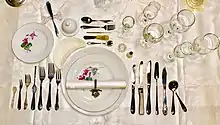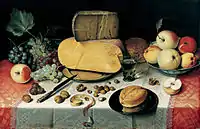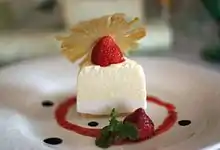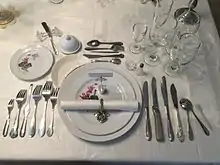Full course dinner
A full-course dinner is a dinner consisting of multiple dishes, or courses. In its simplest form, it can consist of three or four courses; for example: first course, a main course, and dessert.
 An American 13 course table setting | |
| Type | Meal |
|---|---|
| Course | At least three |
| Part of a series on |
| Meals |
|---|
 |
| Meals |
| Components and courses |
| Related concepts |
Basics
A multicourse meal or full-course dinner is a meal of multiple courses, almost invariably eaten in the evening or afternoon. Most Western-world multicourse meals follow a standard sequence, influenced by traditional French haute cuisine. Each course is supposed to be designed with a particular size and genre that befits its place in the sequence. There are variations depending on location and custom. The following is a common sequence for multicourse meals:
- The meal begins with an hors d'oeuvre or appetizer, a small serving that usually does not include red meat. In Italian custom, antipasto is served, usually finger food that does not contain pasta or any starch.
- This may be followed by a variety of dishes, including a possible fish course or other light fare. The number and size of these intermittent courses is entirely dependent on local custom.
- Following these is the main course. This is the most important course and is usually the largest.
- Next comes the salad course, although salad may often refer to a cooked vegetable, rather than the greens most people associate with the word. Note that in America since around 1960, the salad course (usually a small, simple green salad lightly dressed) is served at some point before the main course. Sometimes, the salad also accompanies the cheese course.
- The meal may carry on with a cheese selection, accompanied by an appropriate selection of wine. In many countries cheeses will be served before the meal, and in the United States often between the main course and dessert, just like in most European countries. In the UK, more typically the cheese course will follow dessert. Nuts are also a popular after-meal selection (thus the common saying "from soup to nuts", meaning from beginning to end).
- The meal will often culminate with a dessert, either hot or cold, sometimes followed with a final serving of hot or cold fruit and accompanied by a suitable dessert wine.
Meals like this are generally very formal as well as very expensive. In formal dining, a full-course dinner can consist of 5, 6, 8, 10, 12, or 16 courses, and, in its extreme form, has been known to have 21 courses. In these more formalized dining events, the courses are carefully planned to complement each other gastronomically. The courses are smaller and spread out over a long evening, up to three, four or five hours. They follow conventions of menu planning that have been established over many years. Most courses (excluding some light courses such as sorbets) in the most formal full-course dinners are usually paired with a different wine, beer, liqueur, or other spirit.
In one modern version of service à la russe, courses are brought to the table in sequence. Only empty plates are set in front of each guest and guests make selections from a variety of dishes and fill their own plate. In another, common in restaurants, a filled plate is placed in front of a guest, pre-portioned away from the table. Often the meat is pre-portioned, but diners serve themselves with vegetables and side-dishes. In an American formal dining course, typically each course is served sequentially. Guests are served plates already filled with food in individual portions. Often, guests have an opportunity to choose between vegetarian or meat entrées. There is no opportunity to request something different or to ask for more than a single serving.

In service à la française, food is served "family-style", with all courses on the table at the same time. Guests serve themselves so that all dishes are not served at their optimum temperatures. Alternatively, buffet style is a variation of the French service where all food is available at the correct temperature in a serving space other than the dining table. Guests commute to the buffet to be served or sometimes serve themselves and then carry their plates back to the table.
Table setting

Table settings can be elaborate. More formal settings sometimes include all silverware and glassware that will be needed for the entire meal, and lay out the silverware so that the outermost tools are used for the dishes appearing earliest on the menu. In this scheme, when diners are served the first course, they can depend on finding the correct implement at the outermost edge of the arrangement.
A 13 course place setting includes multiple utensils, receptacles, and vessels. The plate is flanked by a caviar spoon, cocktail fork, escargot fork, bouillon spoon, fish fork and knife, lobster pick, bone marrow spoon, entrée knife and fork, relevé knife and fork, saladé knife and fork. Above the place setting are laid a bread knife (on a knife rest) and plate with personal butter dish, fish bone dish, sorbet spoon, cheese knife, nut pick, and a dessert fork and spoon. To the right of the plate a salt cellar and spoon with pepper is supplied. Glassware includes a water goblet, champagne flute, white wine, red wine, dessert/sherry, and port glasses.
An alternative scheme arranges the place setting so that only the implements needed for the first one or two courses appear in the table setting. As the dinner progresses and new courses arrive, used implements are removed with the dishes, and new silverware is placed next to the plates. This scheme is commonly used when dinners are offered à la carte, so that the most appropriate implement is selected for a given course. For example, some diners may order clear, thin soups and others may order thick, creamy soups. As each of these soups has its own unique spoon,[1] it would be considered improper and impractical to lay out a spoon that may not be needed.
Course composition
Single course meal
- Entree/ Main dish only
Two-course meal
- Soup or Salad for Lunch/Dinner
- Main course
or
- Main course
- Dessert
Three-course meal
- Appetizer
- Main course (sometimes called Entree in North America)
- Dessert
Four-course meal
- Soup/Salad
- Main Course
- Accompaniment
- Dessert
Five-course meal
- Appetizer
- Soup
- Main course
- Dessert
- Cheese
- Coffee
Six-course meal
- Hors d'oeuvres
- Soup
- Fish
- Main Course
- Salad
- Coffee
- Dessert
or
- Amuse-bouche
- Soup
- Hors d'oeuvres
- Main course
- Salad
- Dessert
Example meal
The first class passengers aboard the ill-fated ocean liner R.M.S. Titanic were served the following eleven-course meal in the first class dining saloon on the night of April 14, 1912:[2]
First course—hors d'oeuvre
- Canapés à l'Amiral
- Oysters à la Russe
- White Bordeaux, white Burgundy or chablis (especially with oysters)
Second course—soups
Third course—fish
- Poached salmon with mousseline sauce
- Dry Rhine or moselle
Fourth course—entrées
- Filets mignon lili
- Chicken lyonnaise
- Vegetable marrow farci
- Red Bordeaux
Fifth course—removes
- Lamb with mint sauce
- Calvados-glazed roast duckling with applesauce
- Roast sirloin of beef forestière
- Château potatoes
- Minted green pea timbales
- Creamed carrots
- Boiled rice
- Parmentier and boiled new potatoes
- Red Burgundy or beaujolais
Sixth course—punch or sorbet
- Punch romaine
Seventh course—roast
- Roasted squab on Wilted cress
- Red Burgundy
Eighth course—salad
- Asparagus salad with champagne-saffron vinaigrette
Ninth course—cold dish
- Pâté de foie gras
- Celery
- Sauterne or sweet Rhine wine
Tenth course—sweets
- Waldorf pudding
- Peaches in chartreuse jelly
- Chocolate Painted Eclairs with French vanilla cream
- French Vanilla ice cream
- Sweet dessert wines (muscatel, tokay, sauterne)
Eleventh course—dessert
After dinner
- Coffee, cigars
- Port or cordials
See also
References
- Lininger, Mike. "Spoons". Etiquette Scholar.
- Archbold, Rick; Dana McCauley (1997). Last dinner on the Titanic (1st ed.). New York: Hyperion. p. 67. ISBN 978-0-7868-6303-7.